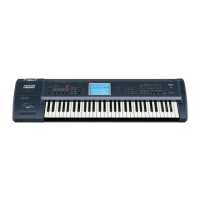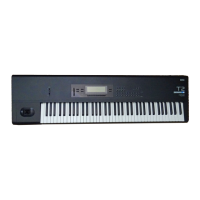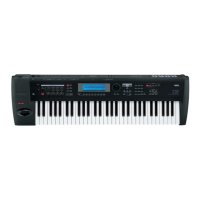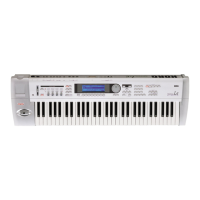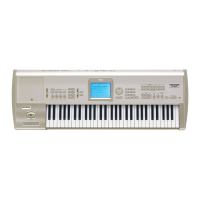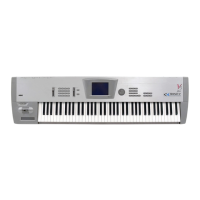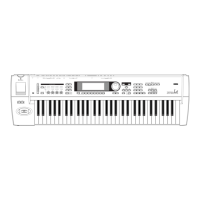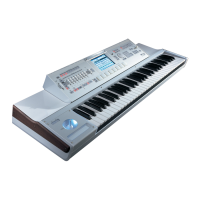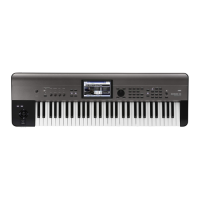Do you have a question about the Korg TR music workstation and is the answer not in the manual?
Details the HI (Hyper Integrated) synthesis system's architecture.
Describes the Tone Generator, Filter, Effect sections, and controllers.
Describes the 16-track MIDI sequencer and its capabilities.
Explains the RPPR function for pattern playback and recording.
Details the dual arpeggiator capabilities for complex sound creation.
Describes the functions and capabilities of Program Mode.
Explains the functions and capabilities of Combination Mode.
Details the functions and capabilities of Sequencer Mode.
Covers MIDI connectors (IN/OUT/THRU) and sampling option inputs.
Instructions for safe power management of the TR and connected equipment.
How to choose a program from the available banks and select a number.
How to choose a combination from the available banks and select a number.
Details the functions of the realtime control knobs, including A-mode operations.
How to enable and use the arpeggiator in Program mode.
Using physical controllers to modify arpeggio sound and playback.
Adjusting arpeggiator tempo, note length (gate), and velocity.
Using performance editor sliders for sound adjustments.
Using realtime controls for parameter editing.
How to assign programs to timbres within a combination.
Steps for connecting audio, setting levels, and specifying recording mode.
Capturing audio samples and adjusting loop points for playback.
Procedures for saving samples and multisamples to SD card or SCSI media.
Transforming multisamples into usable programs for playback.
Connecting audio sources and making initial input settings for sampling.
Adjusting input levels and specifying recording mode (Manual/Auto).
The process of capturing the audio sample, including playback and stopping.
Details on writing data to internal memory, including memory protect.
Describes saving to SD cards, SCSI, and MIDI data dumps.
Steps for saving edited programs and combinations via Utility or REC/WRITE.
Procedures for saving data to SD cards or SCSI media.
Restoring the TR to its factory default settings.
Explains the organization and components of a program.
Introduction to editing program parameters.
Describes pitch, tone, volume, and the compare function for editing.
Settings related to oscillators, waveforms, and basic program configuration.
Details on oscillator settings, multisample selection, and velocity switching.
Explains the organization and basic editing of combinations.
Overview of the sequencer's capabilities, limitations, and features.
Steps to create a song using template songs and preset patterns.
Procedure to create and play cue lists sequentially.
Steps to create and playback RPPR patterns.
Recording RPPR performances in realtime.
General methods for recording tracks and patterns.
Automatically applies settings to a new song for recording.
Overview of the EXB-SMPL sampling hardware features.
The process of manual audio sampling using the start/stop keys.
Detailed steps for manual sampling.
The process of automatic audio sampling.
Enabling/disabling loop playback and using the grid display for editing.
Procedures for creating and editing drum kits.
Detailed steps for editing drum kits, including sample assignment and parameters.
Step-by-step guide for loading data from media.
Lists the types of data that can be saved on external media.
How to set up and use the arpeggiator in Program mode.
Detailed arpeggiator parameter settings like tempo and pattern.
How to use dual arpeggiators simultaneously in Combination and Sequencer modes.
Information on user arpeggio patterns and procedures for editing them.
Details on using and configuring insert effects and their routing.
Details on using and configuring master effects and master EQ.
Guide to solving common problems related to power and the LCD screen.
Troubleshooting issues related to sound output and playback errors.
Troubleshooting problems with recording and arpeggiator start.
Troubleshooting media recognition and installation issues.
Details on synthesis system, polyphony, filters, and waveform memory.
Details on effects, modulation, program/combination counts, and sequencer specs.
Details on audio outputs, inputs, controls, MIDI, SD card, and power.
Chart detailing MIDI message transmission and recognition capabilities.
| Type | Music Workstation |
|---|---|
| Number of Keys | 61 |
| Synthesis Method | PCM |
| Sequencer | 16-track MIDI sequencer |
| Sampling | Optional, via EXB-SMPL board |
| Display | 240 x 64 pixel LCD |
| Arpeggiator | Yes |
| Connections | MIDI In/Out/Thru |
| Power Supply | AC adapter (included) |
